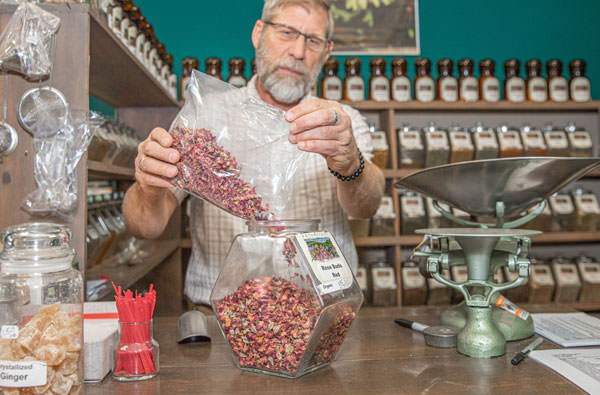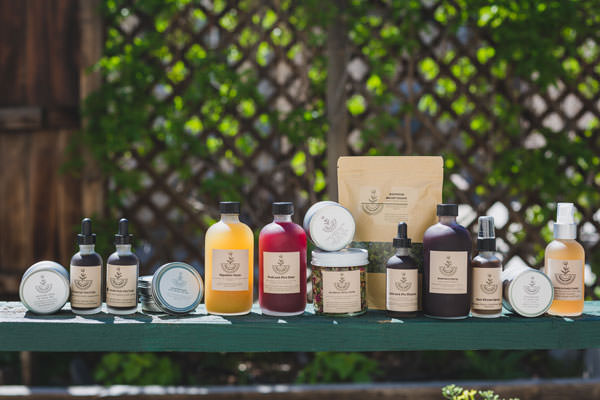Herbal remedies are sprouting up across Reno-Tahoe.
Whether hiking in the backcountry of the Sierra Nevada or walking through a neighborhood in Reno, to the trained eye, the natural world is a medicine cabinet and the key to a healthy life.
“Stinging nettle grows all along the banks of the Truckee River. You can find elderflower, elderberry, rose petals, and wild St. John’s wort. There’s so much out there,” says Brooke Walshaw, an herbalist who crafts medicinal tinctures, tonics, and more from plants she forages and grows for her company, Terroir Herbals.
Stinging nettle has been used for centuries to treat painful muscles and joints, eczema, arthritis, gout, anemia, and urinary issues, to name a few. Walshaw harvests it to put in teas and tinctures, and during springtime, when it grows in abundance, she’ll even make it into pesto. And elderberry — rich in flavonoids and high in vitamin C, vitamin A, bioflavonoids, beta carotene, and iron — makes its way into her syrup with antimicrobials ginger and cinnamon to fight colds and the flu.
“My interest in medicinal herbalism started from a simple cup of chamomile tea that I grew myself. I realized that there were so many beneficial plants growing around me that I could use to promote my health,” Walshaw explains. “What better medicine is there than one that is naturally occurring in my physical environment?”
Seven years ago, she began making remedies for herself and friends. She read everything she could get her hands on about herbalism, attended workshops, and took online courses at the Chestnut School of Herbalism in N.C.
In addition to sustainably harvesting in the wild, Walshaw grows native plants such as yarrow, nettle, and elderberry at Loping Coyote Farms, a permaculture farm in Reno. She either infuses the herbs into oil, vinegar, or alcohol, or dries and turns them into an herbal tea blend. She sells her goods online and at craft fairs and farmers’ markets.
“One of my biggest sellers is a digestion tonic, which is made from a local vinegar and has a lot of stimulating herbs in it such as fennel, ginger, horseradish, and peppermint,” Walshaw says.

Rosebuds are among the natural products sold in bulk by Tom Stewart, owner of Truckee Meadow Herbs in Reno. Photo by Shaun Hunter
Natural prescription
“I think that herbalism has gained a resurgence in popularity,” Walshaw adds. “I think that people are beginning to take their food systems and foodshed more seriously, to understand the importance of local food and that it can also translate to local medicine.”
Not surprisingly, the wellness industry continues its meteoric rise, with the industry having grown by 6.4 percent annually from 2015 to 2017, from a $3.7 trillion to a $4.2 trillion market — nearly twice as fast as global economic growth, according to the Global Wellness Institute. Despite the fact that evidence-based research is limited on the health benefits of the thousands of herbs available on the market, it’s clear that people are beginning to pay more attention to their own health and explore alternative methods for maintaining wellness.
“The popularity of herbs has definitely reached the mainstream, and there are many doctors who utilize them. People often come into my shop to get the herbs they were prescribed,” says Tom Stewart, herbalist and owner of Truckee Meadow Herbs in Reno.
In 1982, Stewart opened his store on Wells Avenue, where he now sells nearly 2,500 natural health products, including an estimated 250 herbs in bulk.
Growing up, Stewart was introduced to functional plants in Boy Scouts. As a teenager, he found mentorship in an 85-year-old Christian Scientist neighbor who, for religious beliefs, maintained her health through an extensive knowledge of plants, which she passed on to Stewart.
“One day, she was having a hemorrhage in her bladder … she refused to get in the ambulance and instead took cayenne pepper to stop the bleeding and uva ursi leaf, which helps the whole bladder,” Stewart recalls. “She was fine. She lived to be 95 years old, never having seen a doctor, and passed away peacefully in her sleep.”
Today, Stewart hosts classes and nature walks, where he instructs people about herbs they can find in nature or cultivate in their own backyards.
“I have a wild garden,” he says. “I think people come over and expect better-trained herbs, like sage and thyme, but I have dandelions everywhere, which is a great one for cleansing the liver, and it’s also good for the kidneys and loaded with minerals as well.”
For those customers new to medicinal herbs, Stewart talks with them about their ailments or areas of health they’d like to improve. For those looking to learn about herbs themselves, he recommends The Way of Herbs by Michael Tierra.
Dr. Kimball Chatfield, an herbalist, acupuncturist, and doctor of Oriental medicine, incorporates medicinal plants into his practice at Lake Tahoe Acupuncture & Wellness in South Lake Tahoe.
“If a person comes to see me, we find out what way will help get them healed or feel better and use whatever nutritional and botanical supplements or lifestyle changes are needed,” Chatfield says. “Herbs are a very important part of traditional Chinese medicine.”
According to Chatfield, who’s penned two books, Medicine From the Mountains: Medicinal Plants of the Sierra Nevada and Astragalus: Ancient Herb for Modern Times, the backcountry of the Sierra is rife with herbs that can benefit the body.
“You can find arnica, which is a great topical remedy for bruises, and yarrow, which is probably the most eclectic plant in terms of uses,” Chatfield says.
The plant, which has bunches of small white flowers, can be used for everything from fever reduction to relief from heavy menstruation.
“There are several varieties of mint that you can find in the Sierra that are great for digestion,” he adds.
But when it comes to foraging in the wild, Chatfield cautions that people need to be absolutely certain about the plants before ingesting them, and they also should practice sustainable harvesting so as not to disrupt the plants’ survival going forward.
Above all, he advises being safe: “People shouldn’t go out and start picking things they don’t know. Plants do have very strong functions. They can be extremely toxic, but they also have the immense capability to heal.”
Claire McArthur is a freelance writer with a passion for herbal remedies and wild foraging. You can find her out in the mountains with her nose in a field guide no matter the season.
Elderberry Syrup
(courtesy of Brooke Walshaw, owner of Terroir Herbals)
“This recipe is an easy way to boost immunity when the cold or flu strikes, plus it tastes great,” Walshaw says. “Elderberry is a powerhouse: It is considered an immunomodulator (an herb capable of modifying or regulating immune function), and the berries are nutritious, rich in flavonoids, and high in vitamin C, vitamin A, bioflavonoids, beta carotene, and iron. I like to combine it with both ginger and cinnamon, which are antibacterial spices.”
2 cups fresh elderberries or 1 cup dried elderberries
6 cups water
¼ ounce fresh ginger
1 cinnamon stick
1½ cups raw honey
Place berries in water and bring to a boil. Lower heat and simmer 35 minutes. Strain berries and return liquid to heat. Simmer gently for another 45 to 60 minutes, or until 2 to 3 cups of liquid remain.
Remove liquid from heat, then add ginger and cinnamon stick. Cover and let aromatics steep in mixture until liquid reaches room temperature. Strain. Stir in raw honey. Bottle, label, and refrigerate.
Walshaw suggests taking 2 teaspoons every 3 hours at the first sign of a cold or flu.*
*Note: The above should not be taken as medical advice.
RESOURCES
Truckee Meadow Herbs
1170 S. Wells Ave., Ste. 4, Reno
775-786-8814 • Truckeemeadowherbs.com
Lake Tahoe Acupuncture & Wellness
2244 Barton Ave., South Lake Tahoe
530-494-0900 • Laketahoeacupuncture.com
Find Terroir Herbals on Instagram.


